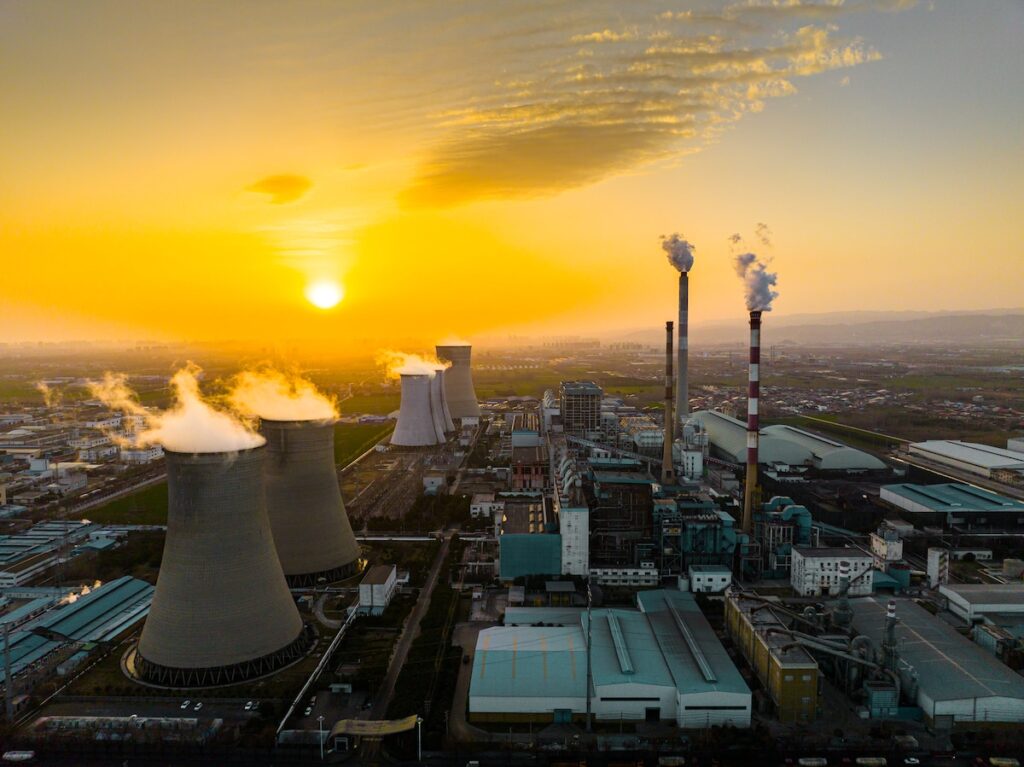3 ‘Most Important’ Greenhouse Gases Reached Record Highs Again Last Year: NOAA Scientists
4 min read
Aerial view of a coal-fired power station in Henan province, China. xijian / E+ / Getty Images
Why you can trust us
Founded in 2005 as an Ohio-based environmental newspaper, EcoWatch is a digital platform dedicated to publishing quality, science-based content on environmental issues, causes, and solutions.
Levels of the three “most important” greenhouse gases — methane, carbon dioxide and nitrous oxide — in the atmosphere reached record highs again in 2023, according to research conducted by scientists with the National Oceanic and Atmospheric Administration (NOAA)’s Global Monitoring Laboratory (GML).
Air samples taken by GML indicated that levels of the heat-trapping gases did not rise as fast as the record leaps of recent years, but were still in accordance with sharp increases recorded in the past decade, a press release from NOAA said.
“NOAA’s long-term air sampling program is essential for tracking causes of climate change and for supporting the U.S. efforts to establish an integrated national greenhouse gas measuring, monitoring and information system,” said Vanda Grubišić, GML’s director, in the press release. “As these numbers show, we still have a lot of work to do to make meaningful progress in reducing the amount of greenhouse gases accumulating in the atmosphere.”
Earth’s average surface carbon dioxide concentration for all of 2023 was 419.3 parts per million (ppm) — up 2.8 ppm over the course of the year. It was the 12th year in a row that carbon dioxide jumped more than two ppm — continuing the most sustained carbon increase rate in NOAA’s 65-year monitoring record.
Even three years in a row of carbon increases of two ppm or higher had not been recorded before 2014. Carbon dioxide levels in the atmosphere have risen to 50 percent higher than in pre-industrial times.
“The 2023 increase is the third-largest in the past decade, likely a result of an ongoing increase of fossil fuel CO2 emissions, coupled with increased fire emissions possibly as a result of the transition from La Niña to El Niño,” said Xin Lan, a scientist with the Cooperative Institute for Research in Environmental Sciences and head of the effort by GML to integrate data from NOAA’s Global Greenhouse Gas Reference Network, which keeps track of greenhouse gas trends worldwide, in the press release.
Levels of methane in the atmosphere increased to a 1,922.6 parts per billion (ppb) average. Methane, while less abundant than carbon, traps more heat. The increase in atmospheric methane last year over 2022 levels was 10.9 ppb, which was lower than previous record rates in 2021 and 2022. However, it was the fifth highest since methane began to increase again in 2007. Current levels of atmospheric methane are more than 160 percent above those of pre-industrial levels.
Last year’s nitrous oxide levels rose to 336.7 ppb — a jump of one ppb. Nitrous oxide is the third most important greenhouse gas produced by humans.
“Increases in atmospheric nitrous oxide during recent decades are mainly from use of nitrogen fertilizer and manure from the expansion and intensification of agriculture. Nitrous oxide concentrations are 25% higher than the pre-industrial level of 270 ppb,” NOAA said.
More than 15,000 samples were collected by GML by global monitoring stations last year. They were then analyzed in a Boulder, Colorado, laboratory. The NOAA-run Global Greenhouse Gas Reference Network (GGGRN) includes roughly 53 sampling sites worldwide and 20 tall tower sites, as well as North American aircraft operation sites.
NOAA said carbon dioxide is the most important greenhouse gas contributing to climate change. Carbon produced by humans has gone up from 10.9 billion tons annually in the 1960s to roughly 36.6 billion tons in 2023. The Global Carbon Project uses GGGRN measurements to calculate net impacts of global carbon sinks and emissions and said last year’s carbon emissions set a new record.
“The amount of CO2 in the atmosphere today is comparable to where it was around 4.3 million years ago during the mid-Pliocene epoch, when sea level was about 75 feet higher than today, the average temperature was 7 degrees Fahrenheit higher than in pre-industrial times, and large forests occupied areas of the Arctic that are now tundra,” the press release said.
Approximately half of fossil fuel emissions have been absorbed into the surface of the planet by land and ocean ecosystems like grasslands and forests. Ocean carbon contributes to acidification, which impacts marine life as well as humans. The world’s oceans have absorbed roughly 90 percent of excess atmospheric heat trapped by greenhouse gases.
A study by NASA and NOAA scientists in 2022 — coupled with further research by NOAA in 2023 — suggests that upwards of 85 percent of the methane emissions increase between 2006 and 2021 came from higher microbial emissions from agriculture, livestock, waste generated by humans, including agriculture, wetlands and other water-based sources. The balance was found to be caused by increased fossil fuel emissions.
Scientists with NOAA are looking into the likelihood that climate change is leading to wetlands producing increasing methane emissions, which in turn influence the climate in a feedback loop. However, the precise reasons for the recent rise in methane are not completely understood.
“In addition to the record high methane growth in 2020-2022, we also observed sharp changes in the isotope composition of the methane that indicates an even more dominant role of microbial emission increase,” Lan said in the press release.
Subscribe to get exclusive updates in our daily newsletter!
By signing up, you agree to the Terms of Use and Privacy Policy & to receive electronic communications from EcoWatch Media Group, which may include marketing promotions, advertisements and sponsored content.





